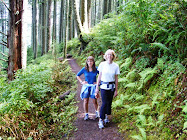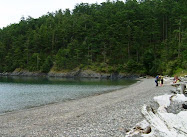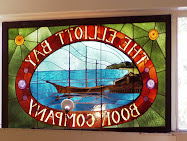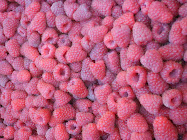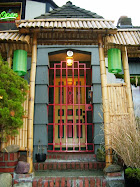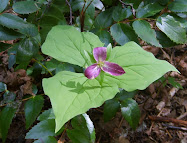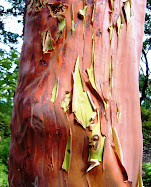 I wake up excited for today's scheduled sea kayaking trip with Sitka Sound Ocean Adventures, thankful that yesterday's drenching rain has subsided. Although rain doesn't stop true Pacific Northwesterners and SE Alaskans from getting outside, I'm glad for the break in the weather.
I wake up excited for today's scheduled sea kayaking trip with Sitka Sound Ocean Adventures, thankful that yesterday's drenching rain has subsided. Although rain doesn't stop true Pacific Northwesterners and SE Alaskans from getting outside, I'm glad for the break in the weather. Kayaking in Sitka Sound again has been on my list since my first trip kayaking here 5 years ago. It's my third and last day in beautiful, friendly Sitka, Alaska, before catching the ferry home to Washington, so I'm saving the best for last.
When I arrive at Sitka Sound Ocean Adventures' big blue bus at Crescent Harbor for the 3.5-hour guided Island Paddle & Lost Fort Trek, Dave and Lydia from Indiana, the other two signed up for today's trip, are already here getting ready.
"Did you bring rain pants?" asks owner Alison Dunlap, who hands me a pair of paddling pants that fit perfectly. Soon we're down on the boat launch, getting the run-down on paddling safety and kayak handling from our guide Chris.
After launching into Sitka Sound, Chris guides us out and around the jetty into the smooth water. As we ease past several houses clinging to little islands and rock outcrops, barely above the high tide line, I wonder how they'll fare with rising sea levels and higher tides (already happening down south).
Suddenly a huge whiskered brown head pops up above the water's surface about 10 feet away, a curious Steller sea lion. With a big huff exhale, it disappears, then pops up again on the other side of my kayak.
"Should we be scared?" says Dave.
"No," replies Chris calmly. "He's just checking us out."
As we paddle farther out along the edge of the airport runway on Japonski Island toward the wild outer edge of Sitka Sound, the ocean swells pick up and break in big splashes against the rocky shoreline and shoals.
With unpredictable weather and considering Dave's recent shoulder surgery, Chris makes the call to turn back and travel on the inside rather than the outside of Japonski Island, where it's protected.
We're heading to Fort Rousseau Causeway State Historical Park, a remnant U.S. Army installation of old bunkers and artillery platforms from World War II. The Fort Rousseau Causeway, a series of interconnected islands, is part of the Sitka Naval Operating Base and U.S. Army Coastal Defenses National Historic Landmark.
Enroute through Sitka Channel, we pass the city's low-rise waterfront lined with lots and lots of boats. After all, Sitka is on an island and unreachable via road from the mainland.
"Is that the Maverick from the Deadliest Catch?" asks Lydia, pointing to a big black boat ahead. Chris confirms that it is indeed. Since I've never seen that show, the excitement is lost on me.
When we clear Japonski Island, the park is dead ahead, low on the horizon. Chris points out where we'll be landing at a beach. Originally it was several smaller islands close together, but the U.S. Army connected them via constructed causeways.
As soon as we land and walk up the beach to level ground above, there's an old concrete bunker built into the island, covered in the lush vegetation that grows quickly here in this rainy climate.
Before we explore, it's time for a cookie break. Grandma Dixie's delicious homemade cookies are a well-known highlight of each Sitka Sound Ocean Adventure guided trip. In the spirit of a true family business, Dixie is co-owner Alison Dunlap's mom. (Alison co-owns with her husband John and their three children are also part of their team.) My ginger molasses chocolate chip cookie is the best! But I think Chris might say the peanut butter is the best...or Lydia might say the cherry oatmeal.
 |
| Chris went for the peanut butter cookie. |
After we transition from thick stands of alder and salmonberry into moss-carpeted young Sitka spruce forest, Chris tells us to put on the headlamps he provided and points to a bunker opening in the woods. We step single-file into the dank, dark bunker hallway, watching out for tangled old electric wiring and debris on the floor.
As I glance down, the beam of my headlamp catches something shiny and greenish, larger than a huge beetle, scurrying past my feet. It's all I can do to not squeal and jump. Slugs are slimy, but they don't scurry.
"Centipede," says Dave. A light-deprived centipede for sure.
Inside the bunker, where I didn't get any decent shots, it's a bit claustrophobic. I wouldn't want to spend a night in here, which the soldiers likely did for weeks or months on end. I'm glad to emerge back into the daylight and inhale the fresh sea salty air.
If you're interested in military history during World War II and Sitka's role, read more about this site and area here.
Our paddle back goes quickly, with little breeze and a somewhat brighter sky. It's Sitka, land of "many shades of gray," so clouds still hover overhead.
Too soon we're back on land, this fun "soft" adventure over. Alison hands me something I forgot at the Bay View Pub last night, now returned safely via several honest, helpful Sitkans, and I can't resist giving her a hug. Maybe it's not just for something returned, but also perhaps Alison with her amiable, competent, engaging manner represents Sitka to me and its easy, friendly spirit.
Thanks to Chris for being an enthusiastic and capable guide, to Dave and Lydia for wearing bright colors that popped well against the gray sky and water in these photos, and special thanks to Alison. You're the best!
Happy trails and thanks for visiting Pacific Northwest Seasons! In between blog posts, visit Pacific NW Seasons on FaceBook, Twitter, and Instagram for more Northwest photos and outdoors news.
When You Go
Sitka Sound Ocean Adventures offers several guided trips as well as kayak rentals and transport for longer expeditions. The weather will be what it will be, but bring rain gear just in case. We paddled in roomy and stable double kayaks, the norm for the guided trips. They provide a small bottle of water and a big cookie, but you might want to bring your own water to supplement.







































